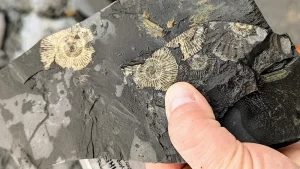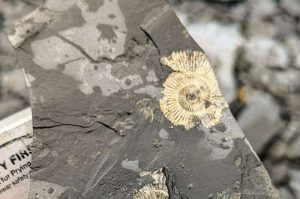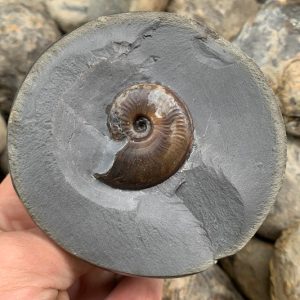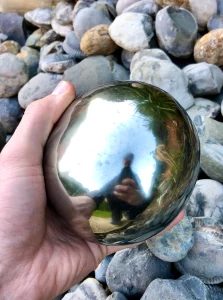In the enthralling world of amateur archaeology, a startling discovery has recently been made by a fossil hunter—an ancient ‘golden snitch’ harboring a 185-million-year-old extinct sea creature within thousands of eggs.

This unique find, reminiscent of the Quidditch ball from the wizarding world, showcases spiral-shaped fossils of cleviceras, an extinct type of cephalopod creature, encased in a rock adorned with iron pyrite, commonly known as ‘fool’s gold.’ The golden shimmer of the rock adds an additional layer of fascination to this prehistoric marvel.
Amateur archaeologist Aaron Smith, a 23-year-old medical student, unearthed this extraordinary fossil on Sandsend Beach in Yorkshire. Smith, a seasoned fossil collector, has previously made several notable discoveries dating back to the Jurassic period on the beaches of Whitby.

The golden appearance of the fossil is attributed to the presence of iron pyrite, and when illuminated, it transforms into a shiny, gold-like spectacle. Cleviceras, the extinct cephalopods preserved within these golden spheres, offer a glimpse into ancient marine life, enriching our understanding of the Earth’s history.
Smith’s dedication to fossil hunting is evident, as he emphasizes the importance of perseverance in making such discoveries. Despite the often fruitless searches, the thrill of finding a fossil makes the months of exploration worthwhile.

Unveiling the fossils involves a meticulous process of carefully removing the stone to expose the ancient treasures, a task that can take hundreds of hours.
The golden snitch-like fossils, with their limestone core, are relatively common along the Yorkshire coastline, nestled among stones and shales. Smith’s discovery adds to the collection of remarkable fossils found in the area, contributing to our knowledge of ancient marine ecosystems.

This discovery resonates with a broader scientific context, as recent research challenges previous assumptions about the source of the golden shine in fossils.
A study led by scientists at The University of Texas at Austin reveals that many fossils from Germany’s Posidonia shale, considered among the world’s best-preserved specimens of sea life from the Early Jurassic, do not derive their gleam from pyrite.

Instead, the golden hue results from a mix of minerals, shedding light on the conditions that led to the exceptional preservation of these fossils.
The findings highlight the intricate processes that govern fossilization, emphasizing the role of oxygen in enhancing preservation.

As amateur archaeologists and scientists alike continue to explore and uncover Earth’s ancient secrets, each discovery serves as a testament to the enduring allure of paleontology and the boundless curiosity that drives humanity to explore the mysteries of our planet’s past.





